Harvest Energy from a Single Photovoltaic Cell. Part 1
Nathan Bourgoine, Linear Technology
CHOOSING THE MAXIMUM POWER POINT CONTROL VOLTAGE
Figure 4 shows a model of the maximum power point control mechanism used by the LTC3105. Figure 3 shows the power curve for a PV cell. Note that PV cell power declines sharply from its peak as the cell voltage rises away from peak power. It is thus generally more desirable to err on the side of a lower-than-ideal control voltage, rather than a higher voltage, because the power curve rolls off more sharply on the high side.
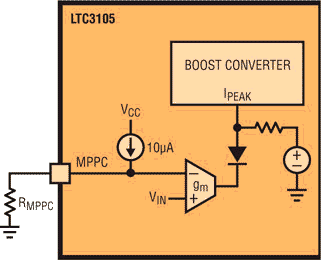 |
|
| Figure 4. | Maximum power point control mechanism. |
When selecting the MPPC tracking voltage, various operating conditions must be considered. Typically, the maximum power point does not move substantially with changes in illumination. As a result, it is possible to choose a single tracking voltage that provides operation near the maximum power point for a wide range of illumination levels. Even though the operating point will not be precisely at the maximum power point at extreme levels of illumination, the reduction in output power from the ideal is usually only 5%–10%.
For the power curve shown in Figure 5, an MPPC voltage of 0.4V yields performance near the maximum power point at either illumination extreme. The voltage difference from the maximum power point is approximately 20mV in both cases, resulting in a power loss of less than 3%.
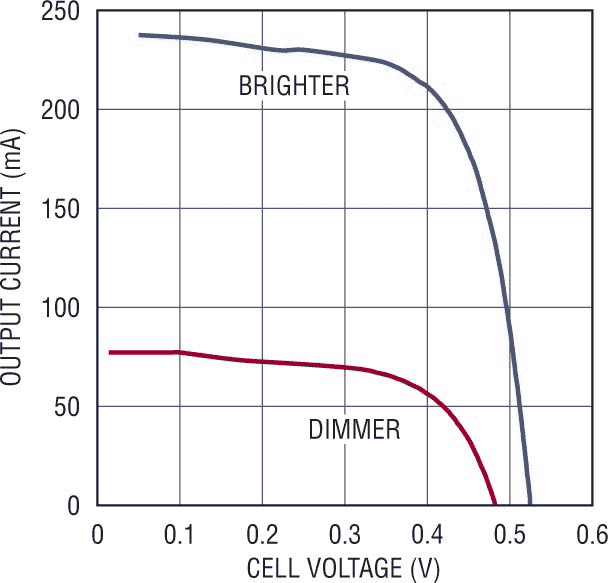 |
|
| Figure 5. | Err on the side of a lower voltage when choosing a maximum power point voltage to avoid the steep drop-off. |
As a rule of thumb, the maximum power point control voltage should be around 75%–80% of the open circuit voltage for the PV cell. Tracking the cell to this voltage results in a cell output current that is 75%–80% of the short-circuit current.
LI-ION BATTERY CHARGING IN OUTDOOR LIGHTING
One of the challenges faced by applications using a photovoltaic source is the lack of input power during darkness and low light conditions. For most applications this necessitates use of energy storage elements such as a supercapacitor or rechargeable battery that is large enough to provide power throughout the longest expected dark period.
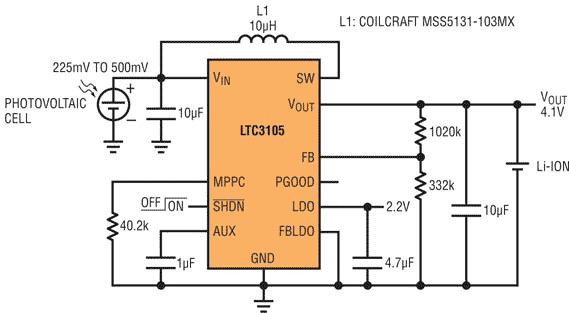 |
|
| Figure 6. | Li-ion charging circuit. |
Figure 7 shows the measured charging current profile using a 2” × 1” polycrystalline PV cell to charge a Li-ion battery using the LTC3105 circuit shown in Figure 6. The upper curve of Figure 7 shows the charging current on a typical clear day with full sun. The lower curve shows the charging current observed over the course of a heavily overcast day. Even under these low light conditions a charging current of 250µA or more was maintained throughout the day totaling 6mAh of charge delivered to the battery.
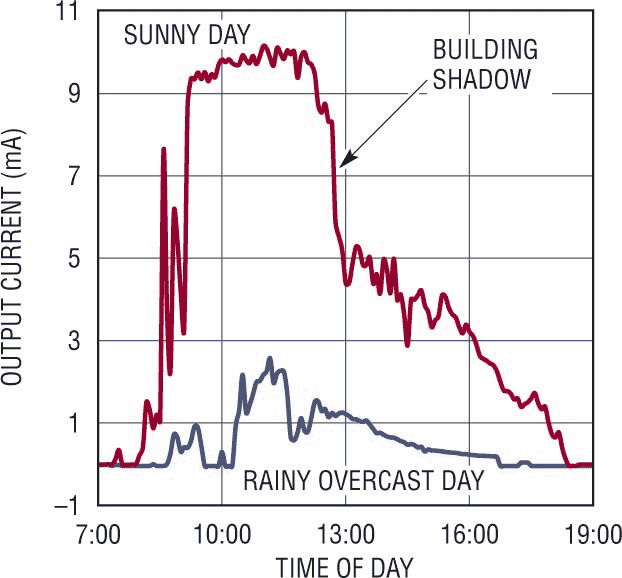 |
|
| Figure 7. | Charging profiles for two square inch photovoltaic cell. |
CHOOSING THE RIGHT ENERGY STORAGE DEVICE
There are many alternatives for storing harvested energy, including a wide variety of rechargeable battery technologies and high energy density capacitors. No one technology is perfect for all applications. When selecting the storage element for your application, consider a number of factors, including the self-discharge rate, maximum charge and discharge current, voltage sensitivity, and cycle lifetime.
The self-discharge rate is particularly important in photovoltaic applications. Given the limited amount of charging current available in most photovoltaic power applications, a high self-discharge rate may consume a large portion of the available energy from the PV source. Some energy storage elements, such as large supercapacitors, may have self-discharge current in excess of 100µA, which could dramatically reduce the net charge accumulated over a daily charge cycle.
Another key consideration is the rate at which the energy storage device can be charged. For example, a lithium coin cell with a maximum charging current of 300µA requires a large resistor between it and the output of the LTC3105 in order to prevent overcurrent conditions. This can put a limit on the amount of energy harvested, decreasing the amount of energy available to the application.
In many cases the charge rate is proportional to another important factor, cycle lifetime. The cycle life of a storage element determines how long it can operate in the field without maintenance. Generally, faster charging and discharging reduces the operational life of the element. Supercapacitors offer very good cycle life, while batteries charged with relatively high currents (charge > 1C) have degraded lifetimes. In addition to the charge and discharge rate, the depth of each charge/discharge cycle can affect the lifetime of batteries, with deeper cycles leading to shorter life times.
With several battery types, notably lithium and thin film, the maximum and minimum voltage must be carefully controlled. The maximum charge voltage is well controlled in LTC3105 applications since the converter terminates charging when the output comes into regulation. To prevent over-discharge, the LTC3105 can be used in conjunction with the LTC4071 shunt battery charger as shown in Figure 8.
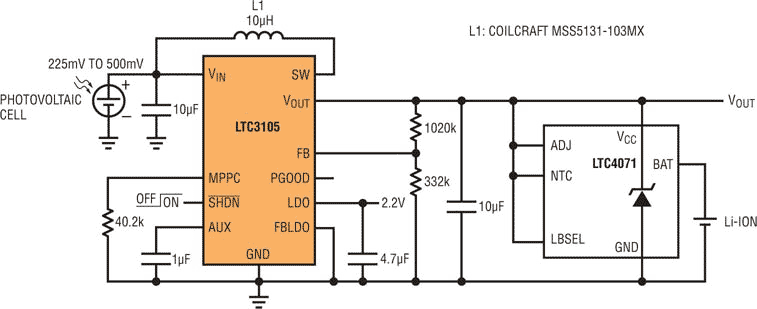 |
|
| Figure 8. | A Li-ion trickle charger operates from a single photovoltaic cell. |
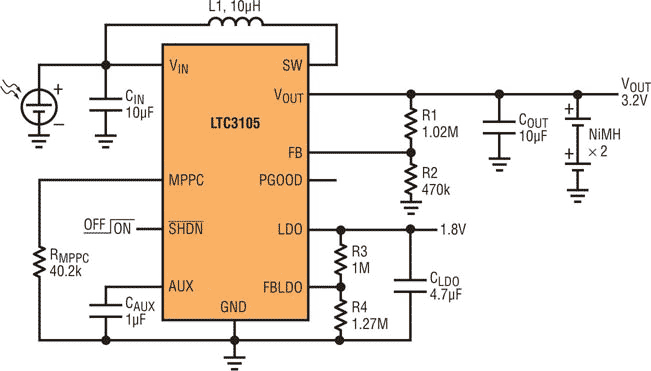 |
|
| Figure 9. | Single-cell photovoltaic NiMH trickle charger. |
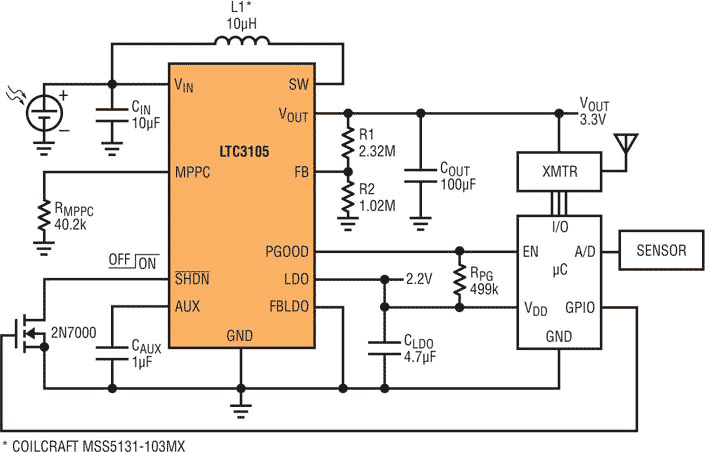 |
|
| Figure 10. | Single-cell-powered remote wireless sensor. |
CONCLUSION
The LTC3105 is a complete single chip solution for energy harvesting from low cost, single photovoltaic cells. Its integrated maximum power point control and low voltage start-up functionality enable direct operation from a single PV cell and ensure optimal energy extraction. The LTC3105 can be used to directly power circuitry or for charging energy storage devices to allow operation through dark or low light periods. The LTC3105 makes it possible to produce autonomous remote sensor nodes, data collection systems and other applications that require grid independence and minimal maintenance.
